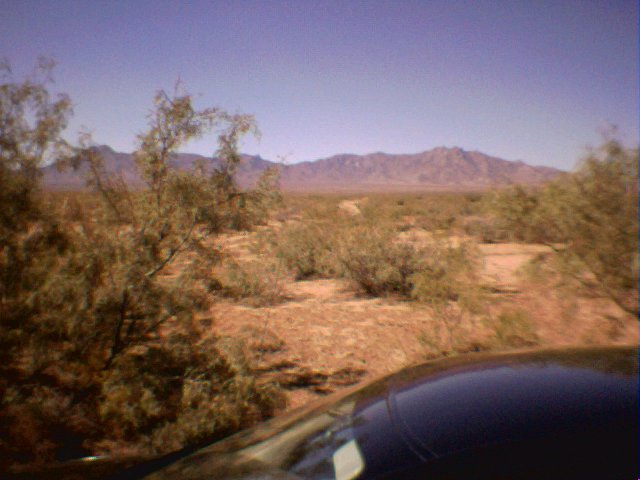
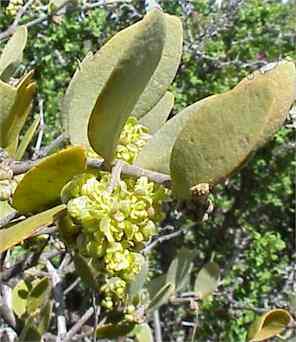
Oct_pics1 - Oct_pics2 - Oct_pics3 DEMING Airport/Car rental Jojoba, Goatnut
Scientific Name: Simmondsia chinensis (Link) C.K. Schneid.
Family: Buxaceae
DEMING, NM


Oct_pics1
- Oct_pics2
- Oct_pics3
DEMING
Airport/Car rental
Jojoba,
Goatnut
Scientific Name: Simmondsia
chinensis (Link) C.K. Schneid.
Family: Buxaceae
http://www.desert-tropicals.com/Plants/Buxaceae/Simmondsia_chinensis.html
1/4 acre Jojoba (pronounced ho-HO-ba) produces $3,000 worth of oil.
Sweet
sorghum Syrup constitutes a meaningful cash crop capable of netting over
$2000/acre for most of its producers
Straw into Gold: Sorghum takes just five acres; soybeans, one acre. They grow mustard on a quarter acre: prepared mustard nets $1,200 a year. They grow garlic on 1/6th of an acre: garlic bulbs and garlic puree nets $800 a year. And they grow horseradish on just 1/10th an acre: prepared horseradish nets $1,000 a year. Bean into packets of tempeh for heath food stores net $1,500 a year.
|
Deming, NM altitude (4331 feet) . The average
temperatures in Deming range from a low of 30.5 degrees with the coldest
month being December. The high is 82.1 degrees with the hottest month
being July. The wettest month is August and the driest months are April
and June. Our winters are noted for their clear skies and sunny weather.
Daytime temperatures, even during the coldest months, average well into
the 50's. As may be expected in arid climates, humidity year round is
low, sometimes as low as 5%.We normally have about 100 days with the
temperatures over 89 degrees but the relative humidity is only 25%. Snow
fall is about 1". Population: 11,000 Fields of cotton and grain
flourish in the seemingly riverless valley around Deming.
The water that sustains them is the subsurface flow of the Mimbres
River, which vanishes into the earth north of the city and reappears in
a lake in the Mexican state of Chihuahua. Stock raising and some
manufacturing augment the economy of this busy county seat, which also
is a growing retirement center. Southeast the Little Florida (flo-REE-da)
Mountains yield an abundance of agate, fire opal, jasper and
semiprecious stones. |
Order your jojoba from Armchair World - Deming Pond
Simmondsia chinensis --- Jojoba --- Simmondsiaceae
Male plant with male flowers.
What is jojoba? It's a plant that can grow in many semi-arid regions of the world, requires little water and maintenance and yields a crop of seeds that have many uses. The seed-oil has been used in lubricants, cosmetics, pharmaceuticals and as a replacement for sperm oil in manufacturing of inks, varnishes, waxes, detergents, resins and plastics. In this era of dwindling natural resources and increased concern for the environment, maybe jojoba's time is now. (AW)
The "oil" from the seeds is unusual in that it is not an oil but a pure liquid ester! The difference between an oil and an ester is small and yet large in terms of properties. Vegetable oils have several alcohol groups on the molecule and some have forked molecules and will eventually oxidize and become rancid. Jojoba has only one alcohol group and is a straight chain molecule; therefore it is not subject to oxidizing and in fact is an anti-oxidant and will never become rancid. However, the liquid ester does have the ability to self polymerize in the presence of sunlight, so it is best to keep it in brown glass bottles, in the dark, or in closed metal cans. Research is presently underway at Jojoba Obispo to investigate the qualities and uses of polymerized jojoba oil.
The liquid ester is chemically almost identical to spermaceti oil which is also a pure ester found in the head of the Sperm whale. Jojoba is the ideal substitute for the oil of the Sperm whale which until restrictions was used for high temperature lubrication, cosmetics and as a lubricant for automatic transmissions. Perhaps jojoba really can save the whales.
Jojoba "oil" is a natural mimic of the oil secreted by human skin
so it may be used to protect and lubricate skin and hair. It is soothing, stops
multitudinous skin problems and protects against premature aging and wrinkling
of the skin caused by exposure to ultra violet radiation.
Soil texture is important as jojoba grows best in sandy or decomposed granite or rocky soils. Even if the fertility of the soil is marginal, jojoba is still able to produce well without the use of fertilizers. However, jojoba plants kept in containers seem to do better with some fertilization.
Irrigation systems are a must when establishing jojoba plantations whether by planting seeds or seedlings. The plants seem to do well on their own after two years of intensive watering in early winter and spring when the jojoba plant maximally utilizes water for growth. This watering period is a plus for the jojoba farmer as jojoba's water requirements will not conflict with the watering requirements for traditional crops. Under ideal conditions of soil, water and sun, the tap root will grow an inch a day; within two years the roots should reach the level of the aquifer thus enabling sufficient growth for seed production without supplemental watering.
In the wild, plants will produce a crop solely utilizing ground water and are
also able to do so when in plantations assuming an underlying aquifer is
available to the roots. If it is possible (and economically viable) watering
should be continued every winter and spring as this will keep layers of water
moving downward, thereby causing the root systems to develop at greater and
greater depths each year. In this case, if the aquifer should drop because of
over drafting, the plants will still have water each year for good seed
production.
Jojoba is usually dioecious (male and female flowers are borne on separate plants). Female flowers are small, pale green and commonly solitary or in clusters at the nodes. Male flowers are yellow, larger, and occur in clusters. Pollination occurs via wind or insect.
The fruit is a green capsule which encloses up to three seeds. When ripe (3 to 6 months after fertilization) the capsule splits and reveals the seed, which is brown, wrinkled and about the size of a small olive (300 to 1,000 seeds/lb). Seed production is generally limited until the fourth year of growth.
The plants are wind pollinated as pollen travels hundreds of feet in a breeze. There are no known insect pollinators other then accidentals. The flowers form in the winter and after pollination grow until they are mature seed in July. The seed skin will dry, shrink and split, whence the slightest breeze will send hundreds of the seeds to the soil below. Seed oil content may vary from 45% to 65%. The properties of the oil are constant regardless of geographical origin of the seed.
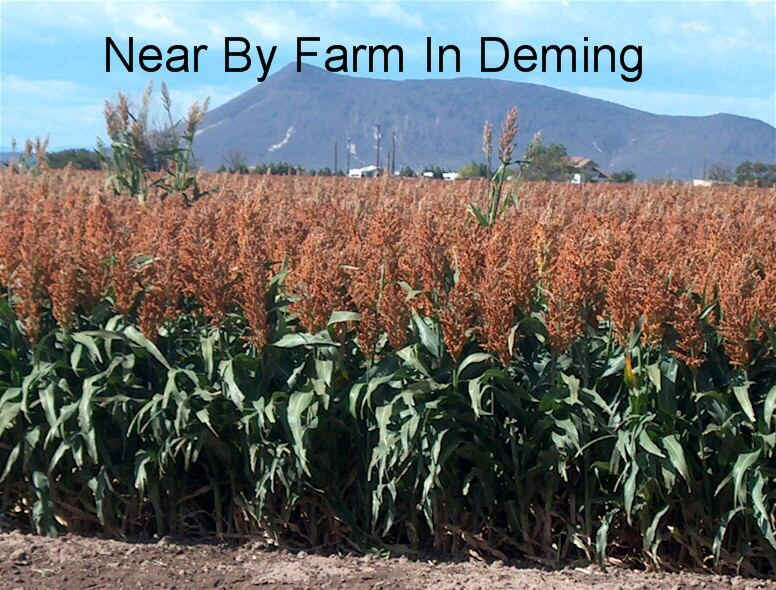
Jojoba can be planted by direct seeding or by transplanting seedlings to the field. In the southwestern U.S. many growers prefer direct seeding because it is less expensive, faster and requires less hand labor. Seed can be germinated in vermiculite or sand at about 80°F. Emergence occurs in 15 to 20 days, and the seedlings are ready for transplanting when they are 6 to 12 in. tall (8 to 10 weeks). Emergence from direct-seeded fields occurs in 15 to 20 days. Propagation from clones or from tissue culture is a more rapid method of varietal improvement.
Jojoba plantations are established by clearing and leveling a site prior to seeding or planting seedlings, rooted cuttings or plantlets produced from tissue culture.
Jojoba can be seeded or transplanted to the field when the soil temperature reaches 70°F. Low soil temperature may delay emergence by as much as 2 to 3 months.
Seeds are planted 1 in. deep, and emergence usually occurs within 20 days. The soil should be kept moist but not wet through emergence.
Individual seeds or seedlings are planted 12 to 18 in. apart in rows. Spacing between rows depends on the harvester to be used. With hand harvesting and cultivation, rows can be as close as 10 ft.
To obtain the proper female:male ratio (6:1), it is advisable to over-plant (7 to 9 lb/acre of seeds) and rogue out excess males later. As male plants flower, they should be thinned out to 1 male every 40 ft on the row. As female plants flower, usually in the third year, any slow-growing or unproductive plants are thinned out, leaving 1 female plant every 2 to 3 ft on the row.
Jojoba generally does not produce an economically useful yield until the fourth or fifth year after planting. Seed yields in natural stands of jojoba range from a few seeds to as much as 30 lb of clean, dry seed per plant. Production of seed varies greatly from plant to plant in a stand and from year to year for a particular plant.
Currently, the average yield of commercial jojoba plantations is less than
300 lb/acre. Plantations that were established with selected higher yielding
clones are capable of producing up to 800 lb/acre. Crop improvement programs at
the University of California-Riverside and the University of Arizona-Tucson are
actively researching consistent productivity.
Alternative
Field Crops The extraction of jojoba oil is performed by screw pressing or
is carried out using a standard oilseed press. Once crushed the oil is filtered
and may be pasteurised and bleached before storing in sealed drums until
required, or sold. The oil is crushed from peanut-sized seeds that are produced
from plantations of hedge-row grown shrubs.
JOJOBA PRUNING MACHINE - Jojoba oil could fuel cars and trucks - CHIHUAHUAN DESERT
Most jojoba oil produced in the U.S. today is sold at a high price for use in cosmetics and hair care products. As many as 300 products containing jojoba have appeared in the U.S. in recent years. As the supply of oil increases and price decreases, more uses will become economically feasible. For example, the viscosity index of jojoba oil is much higher than that of petrolium oil; therefore, it may be used as a high temperature, high pressure lubricant. The stability of jojoba oil makes it attractive to the electronic and computer industries. And since jojoba oil contains no cholesterol or triglycerides and is not broken down by normal metabolic pathways, it may become an important low-calorie oil for human consumption. The oil can be used as an antifoam agent in antibiotics production and as a treatment for skin disorders. Other proposed uses include candles, plasticizers, detergents, fire retardents, transformer oil, and for the leather industry.
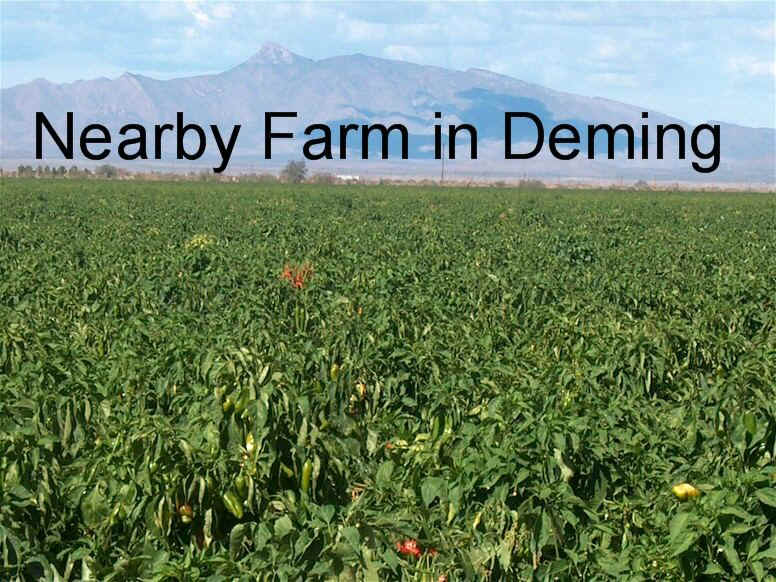
Pepper field, Deming, NM.
The most important vegetables raised are chili peppers and onions; others
include potatoes, lettuce, and pinto beans. Corn, cotton, peanuts, grain
sorghum, and wheat are the most important field crops—most grown on irrigated
farms. Orchard crops are primarily pecans and apples.
Jojoba seed contains a light-gold colored liquid wax ester which is the primary
storage lipid of the plant. This is unlike conventional oilseed crops, such as
soybean, corn, olive, or peanut which produce oils as the primary storage lipid.
Jojoba wax (called oil) makes up 50% of the seed's dry weight. The physical
properties of jojoba oil are: high viscosity, high flash and fire point, high
dielectric constant, high stability and low volatility. Its composition is
little affected by temperatures up to 570°F (300°C). Jojoba oil contains
straight- chained C20 and C22 fatty acids and alcohols and
two unsaturated bonds, which make the oil susceptible to many different types of
chemical manipulations. The extracted oil is relatively pure, non-toxic,
biodegradable, and resistant to rancidity. The meal contains up to 30% protein,
but toxic compounds (simmondsins)
make it currently hazardous as an animal feed.
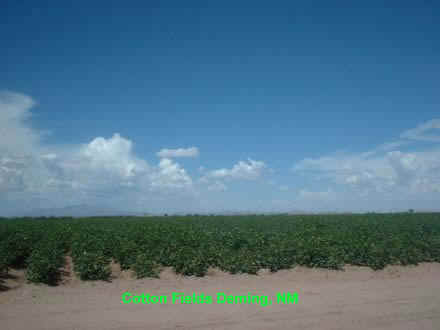
Jojoba: Alternative Field Crops Manual - University of Wisconsin and University of Minnesota
Jojoba Fact Sheet - Purdue University
Jojoba: A Unique Liquid Wax Producer from the American Desert in Advances in New Crops - Purdue University
Jojoba - Rural Industries Research & Development Corporation, Australia
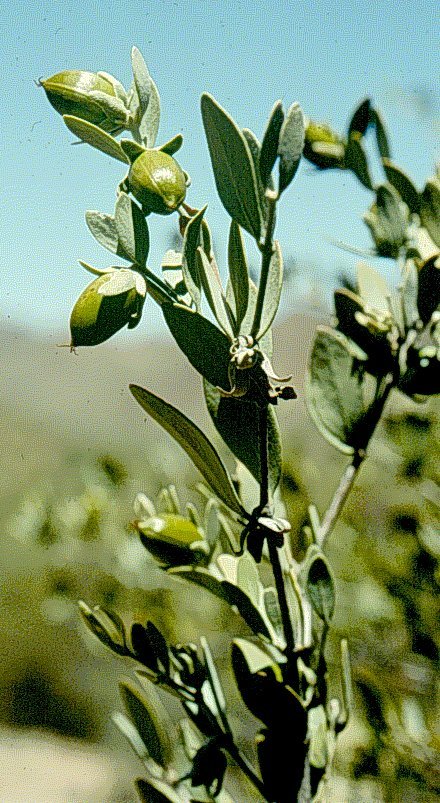
Jojoba oil is cleaner substitute for diesel
AL-AIN, UNITED ARAB EMIRATES, Apr 23: A nut oil widely used in cosmetics and shampoos could one day be powering cars and trucks. Scientists have found that jojoba oil is a viable alternative to diesel fuel. In early tests, jojoba-fuelled engines performed just as well as diesels. They also produced fewer pollutants, and ran more quietly and for longer.
Jojoba is a desert shrub that can reach up to 4.5 metres high and typically lives more than 150 years, producing nuts that yield half their volume in oil. The oil is used as a non-greasy skin-smoothing ingredient in cosmetics, and as a base for shampoos and make-up. Engineers believe it has potential as a motor fuel because it releases a lot of energy when it burns, and is chemically stable at high temperatures and pressures, "New Scientist" magazine reported.
A team of scientists from the United Arab Emirates and Egypt tested the idea by attaching an array of sensors to a diesel engine. The engine was run both with regular diesel and a fuel made by adding just a dash of methanol and a catalyst to raw Jojoba oil. Jojoba fuel matched diesel for torque and power over the tested engine speeds of between 1,000 and 2,000 revolutions per minute. The fuel contains less carbon than diesel, which means lower emissions of carbon monoxide, carbon dioxide and soot. Jojoba also contains no sulphur, which normally shortens the lifespan of diesel engines because of the corrosive effects of sulphuric acid. It is also safer to store and transport, having a higher "flashpoint" than diesel so that it is less likely to explode. The major obstacle in the way of Jojoba fuel is growing enough Jojoba plants.
The use of Jojoba as a fuel needs huge quantities of seeds, which would require large investment, probably by the Government or private sector, said Mohamed Selim, from the United Arab Emirates University at Al-Ain, who led the research. But he said Jojoba fuel could become popular in regions where the shrub can be grown easily.
The plant has been grown for decades in the American South-West and NorthWest Mexico, and is now cultivated throughout South America and in several Middle Eastern countries. Farmers in Egypt had already started planting Jojoba shrubs specifically to use the nut oil as a fuel, "New Scientist" reported. (DPA)
Jojoba: the holy grail of desert shrubs
With the decline in profitability of “white gold,” some agriculturalists have turned to an entirely new crop: jojoba (or, somewhat unimaginatively, “green gold”), hailed by its producers as the miracle crop of Egypt’s future.
Jojoba is a low evergreen plant indigenous to the Americas. A resilient shrub, it thrives in hot, arid climates, and requires very little in terms of water or maintenance. In the last 15 years, it was discovered that the small desert bush is ideally suited to Egypt’s climate and soil. And more importantly, the plant’s seeds and extracts yield a seemingly endless array of products and applications.
Processing jojoba seeds yields a sap that is 60 percent pure oil
– chemically classified as a liquid wax – that can be used towards a variety
of industrial and pharmaceutical ends. For example, jojoba oil is used to make
ointments, inks, varnishes, waxes, detergents, pharmaceuticals, resins and
plastics; it can be employed as an additive in motor, transmission and gear
oils; and it’s a good substitute for the oil of the sperm whale – which is
used in cosmetics as well as automatic-transmission lubricants.
According to one of the many websites dedicated to the myriad uses of jojoba
oil, it is also “a natural mimic” of the oil secreted by human skin, so its
application reportedly protects the skin and slows the ageing process. It was
even recently reported that researchers at Helwan University in Cairo and the
United Arab Emirates University have been testing jojoba oil as a substitute for
diesel fuel, with promising results (the patent, however, appears to have
already been snapped up by an American company).
Dr. Nabil S. El Mouguy is Egypt’s authority on fertilization, irrigation and oil extraction methods for jojoba. He is also the sole national supplier of jojoba seedlings. His jojoba farm, about 100 kilometers outside of Cairo, is Egypt’s pilot project for the crop.
According to El Mouguy, Egypt produces about 10 tons of jojoba oil annually – enough to satisfy the few companies that manufacture pharmaceutical products with the oil. But none of El Mouguy’s production is exported, although the world market demand for jojoba oil is about 200,000 tons (and that, El Mouguy pointed out, was “without knowledge of some of the new applications”). Total world production, meanwhile, is only about 10,000 tons.
On the international market, jojoba oil sells for $10-20 per pound, depending on the quality. Oil that is labeled and packaged can sell for much more: a bottle of 100 cubic centimeters usually retails for about $6. The main world buyers are Germany and Japan.
The cultivation of jojoba, however, is no easy matter. It takes time and investment, but can yield exponentially increasing returns. The plants don’t start producing seeds until their fourth year. Until then, they need about 50-70 liters of water in the summer and 10-30 liters in winter. By the fourth year, though, one acre will produce 250 to 350 kilograms of seed. Profits start coming by around the eighth year, as mature plants (which at this point can survive a year without being watered) will produce 800 to 1,200 kilograms of seed per acre. Thus, according to El Mouguy, the average investment in jojoba farming is about £E 30,000 per hectare (not counting the cost of water and land) and the average return is about $12,000.
While most of Egypt’s jojoba cultivation is currently is Assiut (where it is overseen by the Assiut governorate, the Ministry of Defense and private businessmen), El Mouguy explained that jojoba could be planted anywhere “from Alexandria to Aswan.” The only place it wouldn’t thrive would be the Delta, he said, because the plant requires well-drained, yellow soil, which the Delta doesn’t have.
El Mouguy maintained that jojoba is a much more profitable crop
than either tobacco or cotton, yielding a much higher return per cubic meter of
water. In fact, El Mouguy predicted, “there will be a boom” of jojoba
cultivation in Egypt’s near future. And if all phases of production – from
oil extraction to packaging – are done locally, the desert shrub could be an
extremely lucrative development for Egypt’s agriculture sector. Ursula Lindsey
Profit
From The CBTPA
Mesquite
trees
The project attempted to demonstrate an economic value to the
harvest of renewable products from mesquite trees rather than their
destruction and sale as timber and firewood. This investigation resulted in the
development of several products based on the flavorful and nutritious beans pods
from these trees. It is important to mention that the mesquite bean pods have
been, for thousands of years, an important source of food for indigenous peoples
in arid lands.
The initial investigations centered on the mesquite forests of the southwest USA
and northern Mexico. A product of acceptable quality was produced. Continued
examination of mesquite forests elsewhere located a highly nutritious and more
flavorful bean in Peru. Among the more complex tasks faced in producing mesquite
meal is the drying process for the pods that is required to reduce the moisture
content to avoid gumming the milling blades. Ordinarily, this has been done with
intensive labor that exposes the pods on the drying racks to sunlight during the
daylight hours. The pods are packed and stored during the nighttime and laid out
for drying during each of 4 to 6 days.
The YONOSE Foundation designed a "low tech" inflatable forced air
dryer that adequately reduces the moisture content of 1-5 tons of pods daily
Grant funding was obtained and a production size dryer was built. Field testing
was conducted at a site near Tucson Arizona, prior to the shipment of the dryer
to Peru where it was integrated into the rural mesquite harvest operation.
|
Sunflower
Seeds
- David |